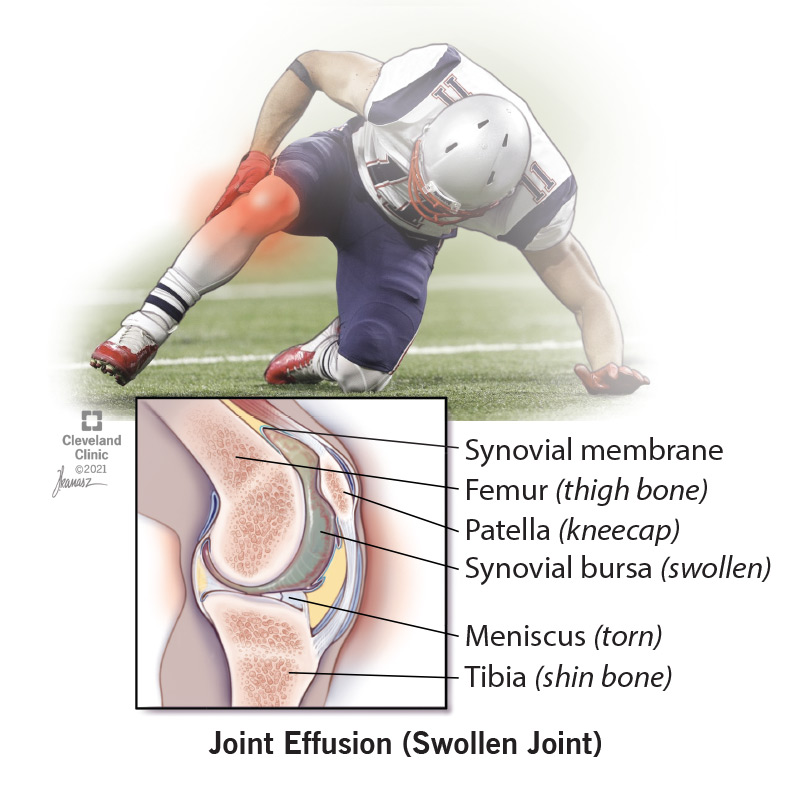If your knee looks larger than usual, you might have joint effusion (a swollen joint). Joint effusion can be a sign of an injury, a type of arthritis or another condition. There are treatments you can try at home in addition to ones prescribed by your healthcare provider.
Advertisement
Cleveland Clinic is a non-profit academic medical center. Advertising on our site helps support our mission. We do not endorse non-Cleveland Clinic products or services. Policy

Joint effusion (a swollen joint) happens when extra fluids flood the tissues around your joint. The fluids make your joint look larger and puffier compared to your other joints. Your bones form joints when two or more of them connect. Your knee, for example, is made up of three bones:
Advertisement
Cleveland Clinic is a non-profit academic medical center. Advertising on our site helps support our mission. We do not endorse non-Cleveland Clinic products or services. Policy
But your joints also consist of tissues that have various purposes:
All of these bones and tissues work together to help your joints function — to help them bend, flex, straighten, rotate and bear your weight. Joint effusion is when fluids enter one or more of these tissues.
Joint effusion can affect your knee and other big joints. Examples include your:
Joint effusion can also affect your small joints, such as your:
Ordinarily, there is a little bit of fluid already in the joint tissues. The fluid can consist of several substances, including:
Advertisement
But, if there are more fluids than usual in your joint, you have effusion (a swollen knee joint). Other symptoms that often go along with a swollen joint include:
These are symptoms of various diseases and conditions.
There are several reasons why your knee or other joints might swell with fluid. The most common reasons include:
The cause of your knee joint effusion determines its care and treatment. Often once the cause of the swollen joint gets treated, the swelling goes away. However, not all causes of a knee joint effusion are curable. For many, treatment consists of managing your symptoms instead of eliminating them. There are several ways healthcare providers manage your swollen joint. Examples include:
Contact your healthcare provider when you need treatment for a swollen joint. They can help you figure out the best treatment for your joint effusion.
Advertisement
If your joint swells from fluid, there are a few steps you can take yourself. At-home remedies for joint effusion include:
You should contact emergency services or go to the emergency department if you have the following symptoms:
Joint effusion plus a fever might mean that you have an infection in your joint (septic arthritis). Septic arthritis can seriously damage your joint. You might even need surgery. See a healthcare provider right away to prevent permanent damage. There are treatments to help you recover from septic arthritis.
Advertisement
Contact your healthcare provider if you have symptoms of arthritis. Although different types of arthritis have different symptoms, there are some common symptoms that include:
Pain sometimes goes along with a joint effusion (swollen joint). You might feel a slight tenderness or a deep ache. Talk to your healthcare provider about what you can do to relieve both the pain and swelling.
How long joint effusion takes to heal depends on what caused it. If one of the bones that makes up the joint breaks, you might have joint effusion for weeks or months. If you have joint effusion because of osteoarthritis, you might deal with swollen joints for your lifetime. There are treatments, though, that can lessen the severity of your symptoms. They don’t have to interrupt your daily life.
Check with your healthcare provider. They can determine if you need treatment for your swollen joint or not. Typically you'll need treatment, even if it's just resting the joint at home.
Joint effusion is where the fluids in the tissues around your joint increase causing your knee, shoulder, ankle or other joint swells up. Treatments help heal the swelling by addressing the cause. There are several actions you can take at home to help heal your joint effusion.
Advertisement
Your swollen joint might be a sign of an injury, infection, arthritis or other condition. It can be unnerving to look at the puffy skin, especially if you don’t know what caused it. Take charge of your health by trying the at-home treatments and also contacting your healthcare provider for help if you have symptoms in addition to joint effusion.
Cleveland Clinic’s primary care providers offer lifelong medical care. From sinus infections and high blood pressure to preventive screening, we’re here for you.

Last reviewed on 10/12/2021.
Learn more about the Health Library and our editorial process.